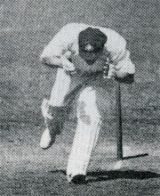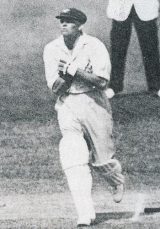A dummy's guide to Bodyline
An outline of the major players and main events during the game's most emotive series
25-Oct-2007
|
|

|
What was Bodyline
It was named after where the England bowlers were aiming - the line of the body - during the 1932-33 Ashes series in Australia. It might be common now for bowlers to want to hit the batsmen with throat balls, but back then things were more genteel, there was only minimal protection and the deliveries were generally full.
It was named after where the England bowlers were aiming - the line of the body - during the 1932-33 Ashes series in Australia. It might be common now for bowlers to want to hit the batsmen with throat balls, but back then things were more genteel, there was only minimal protection and the deliveries were generally full.
How did it work?
There were no fielding restrictions, so players were planted in a close ring, or leg trap, around the batsman on the legside. They were ready to accept the fended catches from the short-pitched deliveries and bouncers, while the men on the boundary collected the shots that passed through or over the infield. It was a tactic that was not only life threatening, but it also made it incredibly difficult for the batsmen to score as they had little room - or time - to swing at the ball. Rule changes after Bodyline led to limits of no more than two fielders being allowed between the square-leg umpire and the wicketkeeper on the leg side.
There were no fielding restrictions, so players were planted in a close ring, or leg trap, around the batsman on the legside. They were ready to accept the fended catches from the short-pitched deliveries and bouncers, while the men on the boundary collected the shots that passed through or over the infield. It was a tactic that was not only life threatening, but it also made it incredibly difficult for the batsmen to score as they had little room - or time - to swing at the ball. Rule changes after Bodyline led to limits of no more than two fielders being allowed between the square-leg umpire and the wicketkeeper on the leg side.
Apart from batsmen being threatened, were there any other repercussions?
As Australia's batsmen continued to suffer painful blows on their hands, hearts and heads, the impact of the series threatened the relationship between Australia and England. Cables were sent back and forth - the issue was also discussed in cabinet - but the diplomacy of the letters and the lack of English correspondents on the tour failed to get across how dangerous things were.
As Australia's batsmen continued to suffer painful blows on their hands, hearts and heads, the impact of the series threatened the relationship between Australia and England. Cables were sent back and forth - the issue was also discussed in cabinet - but the diplomacy of the letters and the lack of English correspondents on the tour failed to get across how dangerous things were.
Why was it introduced for this series?
Because of Don Bradman. After frightening England in 1930 with 974 runs in five Tests, Bradman was England's greatest danger. Douglas Jardine, the England captain, knew if he could beat Bradman he could defeat Australia, so he planned his strategy, which he called leg theory, around a pace attack of Harold Larwood, Bill Voce, Bill Bowes and Gubby Allen. Bradman missed the first Test due to illness and was out first ball in the second before scoring 103 in the next innings.
Because of Don Bradman. After frightening England in 1930 with 974 runs in five Tests, Bradman was England's greatest danger. Douglas Jardine, the England captain, knew if he could beat Bradman he could defeat Australia, so he planned his strategy, which he called leg theory, around a pace attack of Harold Larwood, Bill Voce, Bill Bowes and Gubby Allen. Bradman missed the first Test due to illness and was out first ball in the second before scoring 103 in the next innings.
Did it work?
Statistically, yes. England won 4-1 and Bradman's series average was 56.57, the worst of his career.
Statistically, yes. England won 4-1 and Bradman's series average was 56.57, the worst of his career.
So who was Douglas Jardine?
An upper-class amateur, Jardine is still a hero to many Englishman and despised by Australians. He led England in 15 of his 22 Tests, but the Bodyline series was his greatest triumph (England view) and the worst thing to happen to the game (Australia view). He preferred the Harlequins hat to the MCC cap, hated Australians (the feeling was mutual) and regained the unwinnable Ashes. He played only six more Tests after the series and refused to play against Australia in 1934.
An upper-class amateur, Jardine is still a hero to many Englishman and despised by Australians. He led England in 15 of his 22 Tests, but the Bodyline series was his greatest triumph (England view) and the worst thing to happen to the game (Australia view). He preferred the Harlequins hat to the MCC cap, hated Australians (the feeling was mutual) and regained the unwinnable Ashes. He played only six more Tests after the series and refused to play against Australia in 1934.
Who was Jardine's main weapon?
Harold Larwood was an olden-day version of shock and awe. A small fast bowler from the mines of Nottingham, he bowled like lightning and was the perfect man for the bumper-filled plan. Despite his series-winning 33 wickets, including Bradman's four times, he never played another Test. He had followed his captain's instructions immaculately, but when the controversy continued back in England he refused to sign an apology. While Jardine was hated in Australia, Larwood was appreciated, especially while making 98 in the final Test, and moved to Sydney in 1950.
Harold Larwood was an olden-day version of shock and awe. A small fast bowler from the mines of Nottingham, he bowled like lightning and was the perfect man for the bumper-filled plan. Despite his series-winning 33 wickets, including Bradman's four times, he never played another Test. He had followed his captain's instructions immaculately, but when the controversy continued back in England he refused to sign an apology. While Jardine was hated in Australia, Larwood was appreciated, especially while making 98 in the final Test, and moved to Sydney in 1950.
|
|

|
How fast was he?
Speed cameras were decades away from being invented, but researchers somehow worked out a way to register Larwood's bowling at 96mph. Jeff Thomson holds the record at 99.7mph.
Speed cameras were decades away from being invented, but researchers somehow worked out a way to register Larwood's bowling at 96mph. Jeff Thomson holds the record at 99.7mph.
Was anyone badly hurt?
There were lots of bruises, but not many broken bones. Bert Oldfield, Australia's wicketkeeper, was involved in the most sickening incident of the tour when he missed an attempted pull and his skull was cracked by a Larwood delivery in the third Test at Adelaide. He stumbled away from the crease and was surrounded by England's fielders when Bill Woodfull, the captain, walked out in a business suit to comfort his team-mate.
There were lots of bruises, but not many broken bones. Bert Oldfield, Australia's wicketkeeper, was involved in the most sickening incident of the tour when he missed an attempted pull and his skull was cracked by a Larwood delivery in the third Test at Adelaide. He stumbled away from the crease and was surrounded by England's fielders when Bill Woodfull, the captain, walked out in a business suit to comfort his team-mate.
What did the crowd do?
The spectators had been unhappy since the second Test and there were mounted police stationed outside Adelaide Oval. Fears of a riot increased after Oldfield was hit, but it never happened. Oldfield, whose forehead was cut by the blow, said it was his fault for missing the ball, which was delivered to a conventional field. In 1976 Larwood was one of the pallbearers at Oldfield's funeral.
The spectators had been unhappy since the second Test and there were mounted police stationed outside Adelaide Oval. Fears of a riot increased after Oldfield was hit, but it never happened. Oldfield, whose forehead was cut by the blow, said it was his fault for missing the ball, which was delivered to a conventional field. In 1976 Larwood was one of the pallbearers at Oldfield's funeral.
Did any of the England players protest against Bodyline?
George 'Gubby' Allen stood up to his fellow amateur Jardine while the Nawab of Pataudi, a batsman, refused to field in the leg trap, prompting Jardine to snap: "Ah, I see his highness is a conscientious objector." Allen was allowed to employ his usual fast-bowling methods and picked up 21 wickets for the series, finishing second behind Larwood. He returned to Australia as captain in 1936-37.
George 'Gubby' Allen stood up to his fellow amateur Jardine while the Nawab of Pataudi, a batsman, refused to field in the leg trap, prompting Jardine to snap: "Ah, I see his highness is a conscientious objector." Allen was allowed to employ his usual fast-bowling methods and picked up 21 wickets for the series, finishing second behind Larwood. He returned to Australia as captain in 1936-37.
What was the reaction of the Australians?
A respected and diplomatic captain, Bill Woodfull tried not to show his public anger towards Bodyline. However, during the Adelaide Test, after he had been struck often, including a stinging blow above the heart, Woodfull received a visit in the dressing-room from Pelham Warner, the England manager. Warner wanted to check on the opening batsman's condition and received the immortal Woodfull line: "There are two teams out there. One is trying to play cricket and the other is not."
A respected and diplomatic captain, Bill Woodfull tried not to show his public anger towards Bodyline. However, during the Adelaide Test, after he had been struck often, including a stinging blow above the heart, Woodfull received a visit in the dressing-room from Pelham Warner, the England manager. Warner wanted to check on the opening batsman's condition and received the immortal Woodfull line: "There are two teams out there. One is trying to play cricket and the other is not."
Did the story stay in the dressing room?
No, it was leaked to the newspapers: Warner blamed Jack Fingleton, the journalist playing in Australia's team; Fingleton later said it Bradman. It is one of the many mysteries of the series.
No, it was leaked to the newspapers: Warner blamed Jack Fingleton, the journalist playing in Australia's team; Fingleton later said it Bradman. It is one of the many mysteries of the series.